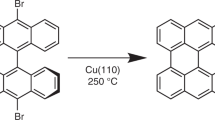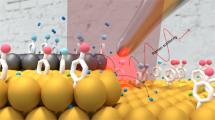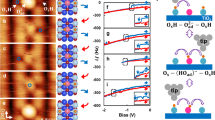Abstract
Hydrogen bonds are the path through which protons and hydrogen atoms can be transferred between molecules. The relay mechanism, in which H-atom transfer occurs in a sequential fashion along hydrogen bonds, plays an essential role in many functional compounds. Here we use the scanning tunnelling microscope to construct and operate a test-bed for real-space observation of H-atom relay reactions at a single-molecule level. We demonstrate that the transfer of H-atoms along hydrogen-bonded chains assembled on a Cu(110) surface is controllable and reversible, and is triggered by excitation of molecular vibrations induced by inelastic tunnelling electrons. The experimental findings are rationalized by ab initio calculations for adsorption geometry, active vibrational modes and reaction pathway, to reach a detailed microscopic picture of the elementary processes.
This is a preview of subscription content, access via your institution
Access options
Subscribe to this journal
Receive 12 print issues and online access
$259.00 per year
only $21.58 per issue
Buy this article
- Purchase on Springer Link
- Instant access to full article PDF
Prices may be subject to local taxes which are calculated during checkout




Similar content being viewed by others
References
Eigler, D. M. & Schweizer, E. K. Positioning single atoms with a scanning tunnelling microscope. Nature 344, 524–526 (1990).
Heinrich, A. J., Lutz, C. P., Gupta, J. A. & Eigler, D. M. Molecule cascades. Science 298, 1381–1387 (2002).
Komeda, T., Kim, Y., Kawai, M., Persson, B. N. J. & Ueba, H. Lateral hopping of molecules induced by excitation of internal vibration mode. Science 295, 2055–2058 (2002).
Stipe, B. C., Razaei, M. A. & Ho, W. Inducing and viewing the rotational motion of a single molecule. Science 279, 1907–1909 (1998).
Stipe, B. C., Razaei, M. A. & Ho, W. Coupling of vibrational excitation to the rotational motion of a single adsorbed molecule. Phys. Rev. Lett. 81, 1263–1266 (1998).
Liljeroth, P., Repp, J. & Meyer, G. Current-induced hydrogen tautomerization and conductance switching of naphthalocyanine molecules. Science 317, 1203–1206 (2007).
Tomatsu, K. et al. An atomic seesaw switch formed by tilted asymmetric Sn–Ge dimers on a Ge (001) surface. Science 315, 1696–1698 (2007).
Pascual, J. I., Lorente, N., Song, Z., Conrad, H. & Rust, H-P. Selectivity in vibrationally mediated single-molecule chemistry. Nature 423, 525–528 (2003).
Stipe, B. C. et al. Single-molecule dissociation by tunneling electrons. Phys. Rev. Lett. 78, 4410–4413 (1997).
Shin, H-J. et al. State-selective dissociation of a single water molecule on an ultrathin MgO film. Nature Mater. 9, 442–447 (2010).
Ho, W. Single-molecule chemistry. J. Chem. Phys. 117, 11033–11061 (2002).
Katano, S., Kim, Y., Hori, M., Trenary, M. & Kawai, M. Reversible control of hydrogenation of a single molecule. Science 316, 1883–1886 (2007).
Kim, Y., Komeda, T. & Kawai, M. Single-molecule reaction and characterization by vibrational excitation. Phys. Rev. Lett. 86, 126104 (2002).
Henzl, J., Mehlhorn, M., Gawronski, H., Rieder, K-H. & Morgenstern, K. Reversible cis–trans isomerization of a single azobenzene molecule. Angew. Chem. Int. Edn Engl. 45, 603–606 (2006).
Maksymovych, P., Sorescu, D. C., Jordan, K. D. & Yates, J. T. Jr Collective reactivity of molecular chains self-assembled on a surface. Science 322, 1664–1667 (2008).
Maréchal, Y. The Hydrogen Bond and the Water Molecule (Elsevier, 2007).
Swada, D. D. The Difference Engine: Charles Babbage and the Quest to Build the First Computer (Penguin, 2002) reprint.
Bureekaew, S. et al. One-dimensional imidazole aggregate in aluminium porous coordination polymers with high proton conductivity. Nature Mater. 8, 831–836 (2009).
Horiuchi, S. & Tokura, Y. Organic ferroelectrics. Nature Mater. 7, 357–366 (2008).
Duan, C. & Majumdar, A. Anomalous ion transport in 2-nm hydrophilic nanochannels. Nature Nanotech. 5, 848–852 (2010).
Bernal, J. D. & Fowler, R. H. A theory of water and ionic solution, with particular reference to hydrogen and hydroxyl ions. J. Chem. Phys. 1, 515–548 (1933).
Agmon, N. The Grotthuss mechanism. Chem. Phys. Lett. 244, 456–462 (1995).
Ando, K. & Hynes, J. T. Molecular mechanism of HCl acid ionization in water: Ab initio potential energy surfaces and Monte Carlo simulations. J. Phys. Chem. B 101, 10464–10478 (1997).
Marx, D., Tuckerman, M. E., Hutter, J. & Parrinello, M. The nature and transport mechanism of hydrated hydroxide ions in aqueous solution. Nature 397, 601–604 (1999).
Swanson, J. M. J. et al. Proton solvation and transport in aqueous and biomolecular systems: Insights from computer simulations. J. Phys. Chem. B 111, 4300–4314 (2007).
Tanner, C., Manca, C. & Leutwyler, S. Probing the threshold to H atom transfer along a hydrogen-bonded ammonia wire. Science 302, 1736–1739 (2003).
Mohammed, O. F., Pines, D., Dreyer, J., Pines, E. & Nibbering, E. T. J. Sequential proton transfer through water bridges in acid-base reactions. Science 310, 83–86 (2005).
Sakota, K., Inoue, N., Komoto, Y. & Sekiya, H. Cooperative triple-proton/hydrogen atom relay in 7-azaindole(CH3OH)2 in the gas phase: Remarkable change in the reaction mechanism from vibrational-mode specific to statistical fashion with increasing internal energy. J. Phys. Chem. A 111, 4596–4603 (2007).
Nagasaka, M., Kondoh, H., Amemiya, K., Ohta, T. & Iwasawa, Y. Proton transfer in a two-dimensional hydrogen-bonding network: Water and hydroxyl on a Pt(111) surface. Phys. Rev. Lett. 100, 106101 (2008).
Kumagai, T. et al. Tunneling dynamics of a hydroxyl group adsorbed on Cu(110). Phys. Rev. B 79, 035423 (2009).
Tang, Q-L. & Chen, Z-X. Influence of aggregation, defects, and contaminant oxygen on water dissociation at Cu(110) surface: A theoretical study. J. Chem. Phys. 127, 104707 (2007).
Ren, J. & Meng, S. First-principles study of water on copper and noble metal (110) surfaces. Phys. Rev. B 77, 054110 (2008).
Tikhodeev, S. G. & Ueba, H. Relation between inelastic electron tunneling and vibrational excitation of single adsorbates on metal surfaces. Phys. Rev. B 70, 125414 (2004).
Motobayashi, K., Kim, Y., Ueba, H. & Kawai, M. Insight into action spectroscopy for single molecule motion and reactions through inelastic electron tunneling. Phys. Rev. Lett. 105, 076101 (2010).
Li, X-Z., Probert, M. I. J., Alavi, A. & Michaelides, A. Quantum nature of the proton in water-hydroxyl overlayers on metal surfaces. Phys. Rev. Lett. 104, 066102 (2010).
Tikhodeev, S. G. & Ueba, H. How vibrationally assisted tunneling with STM affects the motions and reactions of single adsorbates. Phys. Rev. Lett. 102, 246101 (2009).
Yamada, T., Tamamori, S., Okuyama, H. & Aruga, T. Anisotropic water chain growth on Cu(110) observed with scanning tunneling microscopy. Phys. Rev. Lett. 96, 036105 (2006).
Lee, J., Sorescu, D. C., Jordan, K. D. & Yates, J. T. Jr Hydroxyl chain formation on the Cu(110) surface: Watching water dissociation. J. Phys. Chem. C 112, 17672–17677 (2008).
Carrasco, J. et al. A one-dimensional ice structure built from pentagons. Nature Mater. 8, 427–431 (2009).
Kumagai, T., Okuyama, H., Hatta, S., Aruga, T. & Hamada, I. Water clusters on Cu(110): Chain versus cyclic structures. J. Chem. Phys. 134, 024703 (2011).
Perdew, J. P., Burke, K. & Ernzerhof, M. Generalized gradient approximation made simple. Phys. Rev. Lett. 77, 3865–3868 (1996).
Morikawa, Y., Ishii, H. & Seki, K. Theoretical study of n-alkane adsorption on metal surfaces. Phys. Rev. B 69, 041403(R) (2004).
Otani, M. & Sugino, O. First-principles calculations of charged surfaces and interfaces: A plane-wave nonrepeated slab approach. Phys. Rev. B 73, 115407 (2006).
Hamada, I., Otani, M., Sugino, O. & Morikawa, Y. Green’s function method for elimination of the spurious multipole interaction in the surface/interface slab model. Phys. Rev. B 80, 165411 (2009).
Tersoff, J. & Hamann, D. R. Theory and application for the scanning tunneling microscope. Phys. Rev. Lett. 20, 1998–2001 (1983).
Mills, G., Jónsson, H. & Schenter, G. K. Reversible work transition state theory: Application to dissociative adsorption of hydrogen. Surf. Sci. 324, 305–337 (1995).
Kresse, G. & Hafner, J. Ab initio molecular dynamics for liquid metals. Phys. Rev. B 47, 558–561 (1993).
Kresse, G. & Furthmüller, J. Efficient iterative schemes for ab initio total-energy calculations using a plane-wave basis set. Phys. Rev. B 54, 11169–11186 (1996).
Kresse, G. & Joubert, D. From ultrasoft pseudopotentials to the projector augmented-wave method. Phys. Rev. B 59, 1758–1775 (1999).
Acknowledgements
We thank the Supercomputer Center, Institute for Solid State Physics, University of Tokyo, and the Information Technology Center, University of Tokyo, for the use of the facilities. H.O. was supported in part by the Grant-in-Aid for Scientific Research on Priority Areas ‘Molecular Science for Supra Functional Systems’ from the Ministry of Education, Culture, Sports, Science and Technology, Japan. I.H. was supported by the Grant-in-Aid from the Ministry of Education, Culture, Sports, Science and Technology (MEXT), Japan (No. 21740228). H.U. was supported by the Grant-in-Aid for Scientific Research B (No. 18340085) from the Japan Society for the Promotion of Science (JSPS). T.K. acknowledges the support of the JSPS.
Author information
Authors and Affiliations
Contributions
T.K. and H.O. designed and planned the experiments. T.K. and A.S. measured and analysed the STM data. I.H. performed the STATE calculations. T.F. performed the VASP calculations. H.O. supervised the project and H.U. provided guidance for the analysis completed by I.H. and T.F. All authors contributed to the discussion of the results. H.O., I.H., T.F. and H.U. wrote the paper.
Corresponding author
Ethics declarations
Competing interests
The authors declare no competing financial interests.
Supplementary information
Supplementary Information
Supplementary Information (PDF 5745 kb)
Rights and permissions
About this article
Cite this article
Kumagai, T., Shiotari, A., Okuyama, H. et al. H-atom relay reactions in real space. Nature Mater 11, 167–172 (2012). https://doi.org/10.1038/nmat3176
Received:
Accepted:
Published:
Issue Date:
DOI: https://doi.org/10.1038/nmat3176
This article is cited by
-
Direct observation of knock-on reaction with umbrella inversion arising from zero-impact-parameter collision at a surface
Communications Chemistry (2021)
-
Direct observation of water-mediated single-proton transport between hBN surface defects
Nature Nanotechnology (2020)
-
The effect of hydration number on the interfacial transport of sodium ions
Nature (2018)
-
Concyclic CH-π arrays for single-axis rotations of a bowl in a tube
Nature Communications (2018)
-
Weakly perturbative imaging of interfacial water with submolecular resolution by atomic force microscopy
Nature Communications (2018)



